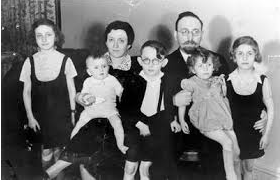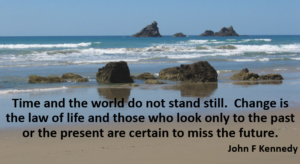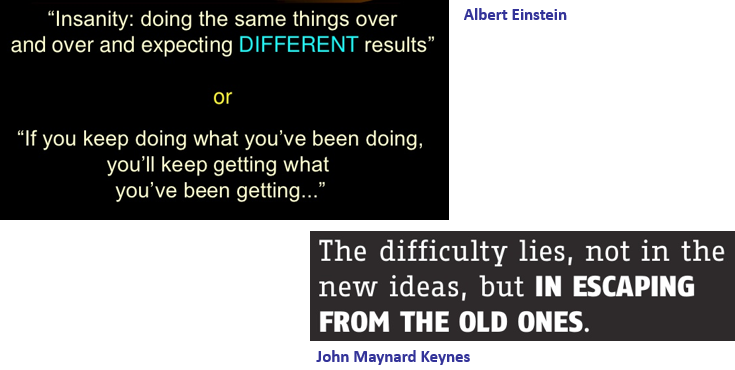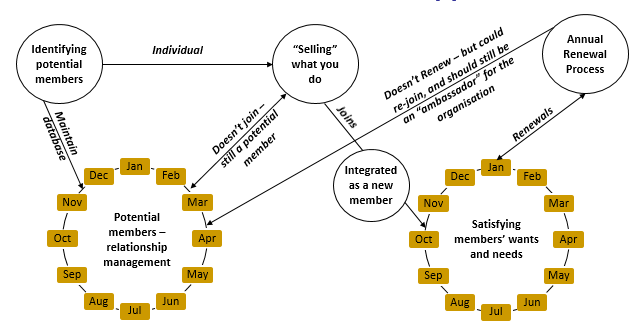Does Your Organisation have a Future?
2012, updated November 2022

Many community organisations reach a point where they ask (or should be asking) this question – does our organisation have a future? Before adopting a negative or defensive attitude to that question it is worth reflecting on some fundamentals:
- What do we really know about:
- Our potential and existing members?
- What keeps existing members interested?
- How to engage our members?
- What might attract new members?
- Would a name-change or a re-focussing of our activities attract new members?
- Do we have a strategy for an ongoing future?
The world has changed, and will continue to change
In reality, much has changed in the last century – for instance:
Early 20th century family:

Early 22nd century family:


Today:
- People will not necessarily give their time (or have time) for traditional voluntary activities, and
- Those who have been leaders in community organisations (baby boomers) are retiring.

Issues for community organisations to consider:
- Are new members joining – if not, why not?
- Are new members leaving after a year or two – if so, why?
- Are member resignations increasing – if so, why?
- Are you struggling to get people to your activities and events – if so, why?
- Are you battling to recruit quality volunteers – if so, why?
- Are you having trouble gaining or retaining sponsors – if so, why??
- Is the average age of your committee members greater than 50?
- Are other organisations or activities competing for your potential and existing members’ engagement?
The self-fulfilling prophecy:

Your organisation will be doomed if you sound or act in a despondent way:
- We can’t get younger people to join (i.e. if you’re young, you’ll be surrounded by the elderly and defeated).
- We can’t get people to join the committee (i.e. if you join there’ll be too few people to do all the work).
- We can’t get a chairman/president (i.e. we’re leaderless).
- We need to put up the subscriptions to cover costs (i.e. it’s becoming more expensive to belong).
- We may have to wind-up (i.e. it’s not if, but when).
Common problems:
- A lack of a positive vision – i.e. no strategic plan,
- Shortages of skilled staff and volunteer leader, and
- Many members resistant to making necessary changes.
Understanding change
Referring to a “generation” used to be a helpful indicator of likely behaviour – but no longer:
- 1926 – 1945 Silent Generation
- 1946 – 1964 Baby Boomers
- 1965 – 1980 Gen X
- 1981 – 1994 Gen Y/ Millennials
- 1995 – 2010 Gen Z
- 2010 – Gen Alpha
Reference to a “generation” is now a less useful indicator of likely behaviour because:
- Patterns of work have changed (working hours, use of technology, both partners working, people holding down more than one job, etc),
- Young families carrying more debt (student loans, housing etc),
- Grandparents still working or are commonly busier with grandchildren, and
- There is a broader range of leisure activities available, at home and away.
The generational, career and family lifecycles have also all changed:
Child 1 – 5 years
Primary student 5 – 12 years
Secondary student 13 – 18 years
Graduate 18 – 21 years Student loans
Career started 18 – 25 years Marrying, and student loans
Career builder 25 – 40 years Young children, and student loans
Consolidator 45 – 60 years Children less dependent
Pre-retirement 60 – 65 years
Retired ??? years Grandparent duties
Do we need to change our thinking?

Do you know what spins your present and potential members’ wheels?
Is your organisation adapting to meet:
- Your present and potential members’ wants and needs?
- Cultural, recreational, social and ethnic changes in society?
Membership is a choice, and then an investment, NOT a donation
Community organisations need to:
- Arouse and maintain the interest of potential and existing members,
- Market themselves – every member must be a marketer,
- Deliver value by making a meaningful contribution to the lives of members,
- Find out what keeps their members interested and involved, and
- Then, satisfy those needs or desires.
Membership mantra:
- An organisation that does not satisfy the needs or desires of its existing members does not deserve to exist, and
- An organisation that does not satisfy the needs or desires of its potential and existing members will wither and die.
Efficient organisational processes maximise opportunities:


Membership recruitment is not why members belong to an organisation, BUT all members should “recruit” new members.
Communicating with potential members

How you communicate with potential and existing members is as important as WHAT you communicate – do it incorrectly, and you may offend/alienate potential and existing members.
Social media is too popular and powerful to be ignored, but it is just another tool:
- Know what it is useful for, and how to use it successfully, and
- Don’t ignore other communication tools.
Potential members and new members:
- Often don’t know what your organisation does, and
- Cannot be expected to know unless you tell them clearly.
Perception is reality – What potential and new members perceive is very often different from reality.
A challenge – Can your organisation’s purposes be briefly and accurately stated (a brief “mission statement” for use in publicity and membership material).
Potential members and new members
You need to: Excite them ✔
To do this, you need to provide: New member packs and “buddies”
You need to: Educate them ✔
To do this, you need to provide: Interesting and fulfilling activities
You need to: Engage them ✔
To do this, you need to provide: Regular newsletters
You need to: Prove your value ✔
To do this, you need to provide: Value for members’ investment of time and money
Great Activities and Events are Essential
Regularly:
- Review activity and event venues, formats, frequency, duration, and content,
- Review engagement mechanisms for activities and events,
- Check whether you are meeting the expectations of members with diverse experiences and expectations, and
- Check whether activities and events are relevant and engaging for newer and younger members.
Imperatives for success – creating a strong member community
- Newer and younger members want to be a part of a dynamic, engaging and innovative organisation.
- Ad hoc volunteering is a decisive transition between uninvolved and involved membership.
Community organisations need to:
- Be true to their purposes (why they exist), and have a plan for achieving those purposes (regular strategic planning is essential),
- Create an engaging, innovative and strong organisation/community – both online and offline,
- Become facilitators and enablers of communities, and
- Connect members in ways that will provide every member with meaningful, positive outcomes
Continuum of membership engagement

Result
Your organisation has a future.
For specific advice about the issues discussed in the article you can contact Mark at mark@nfplaw.co.nz.
